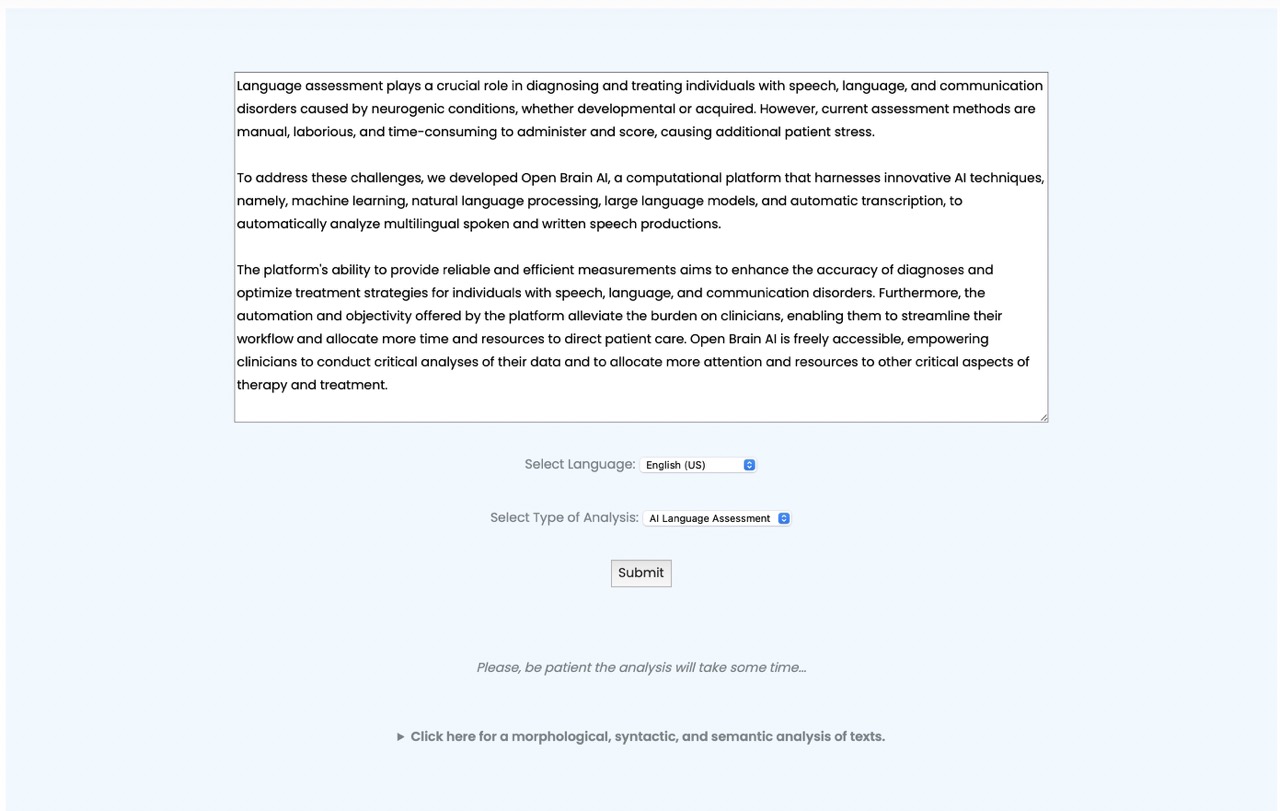Online Platform Services
AI Discourse Analysis & Diagnostics
Language Assessment in the Classroom
Language assessment plays a pivotal role in classroom settings, transcending the mere identification of students with language disorders. Its importance is underscored by its ability to shed light on how students acquire language, pinpoint their areas of strength and vulnerability, and gauge the efficacy of instructional methods. By delving into these insights, educators can calibrate their teaching approaches and extend specialized support to needy students. Standard methods involve manual language assessments, including:
- Standardized Tests: These rigorous tests are meticulously crafted to evaluate a student's prowess across various language dimensions—listening comprehension, speaking, reading, and writing being prominent among them.
- Informal Assessments: Often described as adaptive, these assessments are tailored to resonate with an individual student's needs. They encompass diverse approaches like analyzing language samples, classroom observations, and conducting student interviews.
- Self-assessment: Empowering students to introspect, self-assessment encourages them to evaluate their linguistic capacities. Tools like questionnaires, checklists, and portfolios often facilitate this introspective journey.
The choice of assessment often pivots around the student's unique requirements and the overarching objectives of the assessment. For instance, while a standardized test might be paramount for a student suspected of a language disorder, an educator seeking insights into a student's linguistic learning journey might lean towards informal assessments.
The gleanings from these assessments can be instrumental in tailoring instruction. A student grappling with reading comprehension might benefit from a differently structured text presentation or additional resources. Similarly, challenges with grammar might necessitate intensified instruction on grammatical constructs.
Moreover, these assessments can spotlight students in need of heightened support. A score below the expected benchmark on a standardized test might be a conduit to special education services for a student.
Language assessment is the linchpin that connects teaching to effective learning. Educators are better equipped to bolster instruction and support by decoding students' linguistic learning patterns.
To ensure the utmost efficacy of these assessments, educators should keep in mind:
- Relevance: The assessment should resonate with the student's age and linguistic proficiency.
- Alignment: It's crucial that the assessment dovetails with the classroom's learning aspirations.
- Equitability: Every assessment should champion fairness and be devoid of biases.
- Instructional Utility: Assessment findings should be leveraged to finetune instruction and support.
Adhering to these precepts, educators can harness language assessments to gather invaluable insights into students linguistic capabilities and devise interventions tailored to bolster their linguistic journey.
Computational Language Assessment
Computational language assessment, which employs technology and algorithms to evaluate linguistic abilities, is an improvement over traditional manual assessments in educational settings. Here's a deeper dive into how computational language assessment can complement and improve manual methods:
- 1. Efficiency and Speed: One of the most immediate advantages is speed. While manual assessments might take considerable time for grading and analysis, computational tools can quickly analyze responses, making it feasible for teachers to evaluate larger groups in less time.
- 2. Consistency: Despite their best efforts, human assessors can sometimes exhibit variability in their grading. Computational assessments ensure a consistent grading criterion, removing subjectivity and potential biases.
- 3. Adaptive Testing: Some advanced computational tools adjust the difficulty of questions in real time based on the student's performance. This ensures that students are neither overwhelmed with excessively challenging questions nor bored with overly easy ones.
- 4. Immediate Feedback: Given the speed of computational assessments, students can receive immediate feedback on their performance. This allows for instant rectification of misconceptions and promotes continuous learning.
- 5. Data-Driven Insights: Beyond mere scores, computational assessments can provide deeper insights. For example, it might identify patterns like common student mistakes, areas needing reinforcement, or even predict future performance based on current trends.
- 6. Interactive and Engaging Formats: Digital platforms allow for multimedia content integration. This means assessments can include audio, video, and interactive elements, making them more engaging for students.
- 7. Accessibility: Computational tools can be tailored to cater to students with specific needs, such as text-to-speech for visually impaired students or speech recognition for students with writing difficulties.
- 8. Saving Teacher Time: Instead of spending hours on grading, teachers can redirect their efforts toward planning targeted interventions, curriculum enhancements, or one-on-one student interactions.
- 9. Storage and Record Keeping: Computational tools can automatically archive scores and track student progress over time. This longitudinal data can be invaluable for understanding student growth and areas of improvement.
- 10. Collaboration and Sharing: Computational platforms often allow for easy sharing of results, making it feasible for teachers, parents, and even students to collaboratively discuss progress and strategies.
- 11. Customization: Based on data-driven insights, computational tools can recommend personalized resources or learning pathways for individual students.
However, while there are numerous advantages to computational language assessment, it's essential to integrate them thoughtfully with traditional methods. Manual assessments offer the human touch, understanding nuances, cultural contexts, and a holistic view of a student's abilities, which might sometimes elude even the most sophisticated algorithms. Thus, a blend of both methods, leveraging the strengths of each, would be most effective in classroom settings.
More Themistocleous (2023). Open Brain AI. Computational Language Assessment on the Web.




